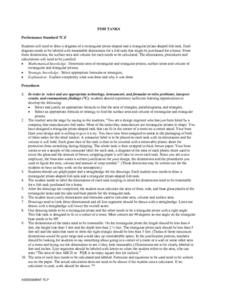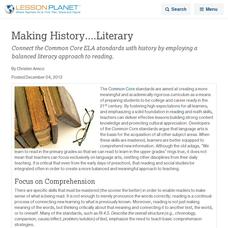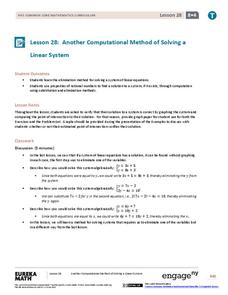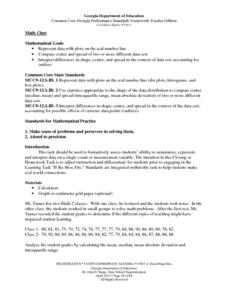Curated OER
Fish Tanks: Volume and Surface Area
Given a very realistic challenge, your young geometers design residential fish tanks in rectangular and triangular prism shapes. They compute the volume of water each will hold. They also determine the size of plastic covers for each...
Curated OER
Making History....Literary
Connect the Common Core ELA standards with history by employing a balanced literacy approach to reading.
S2tem Centers SC
Investigating Chance Processes of Probability
How likely is it that the school cafeteria will serve chicken tomorrow? Discover the concept of probability with the roll of the dice. Pupils evaluate the liklihood of several statments about everyday life. Then, a mathematical...
EngageNY
Another Computational Model of Solving a Linear System
The process of elimination really works! Use elimination when substitution isn't doing the job. The 29th segment in a series of 33 introduces the elimination method to solving linear systems. Pupils work several exercises to grasp the...
Curated OER
Vocabulary Words Kindergarten
Improve your kindergartners' math and science vocabulary with flash cards and word walls. Based on the vocabulary in the Common Core standards, the cards use illustrations to show the meanings of many math terms and descriptions.
Intel
Choreographing Math
Leaners investigate families of linear functions through dance. They choreograph dance moves to model nine unique linear functions of their choosing. Using their dance moves, teams create a video presentation complete with music and...
Curated OER
Candy Machine
Using the concept of a candy vending machine, young mathematicians explore the sugar ratios found in different types of candy. Using the provided information, class members calculate and compare different ratios in order to find the...
Georgia Department of Education
Math Class
Young analysts use real (provided) data from a class's test scores to practice using statistical tools. Not only do learners calculate measures of center and spread (including mean, median, deviation, and IQ range), but also use this...
Kenan Fellows
Math Made Simple as 1-2-3: Simplified Educational Approach to Algebra
Writing an equation of a line is as easy as m and b. A lesson presentation gives individuals different strategies for writing equations of lines. Some items provide a slope and a point while others provide two points. Whatever the given,...
BioEd Online
Good Stress for Your Body
Stress the importance of the different types of pressure our mind and body experience in a lesson about how certain types of stress are actually necessary and good for our bodies. As astronauts and people with injuries can attest, not...
Curated OER
Place Value Review
Review various aspects related to place value with this easy-to-follow presentation. Learners can review the base ten system, see representations, and read descriptions of ones, tens, hundreds, and thousands, and numbers in expanded...
Curated OER
Classroom Supplies
Challenge young mathematicians to buy classroom supplies by staying within the means of a $1,000 budget. The mathematical activity provides learners with the opportunity to decide what items from the supply list would benefit a class of...
Oregon Department of Education
Building and Expanding Patterns
The generation of a number, or shape pattern, is the focus of this math lesson. Pupils are presented with a variety of patterns shapes, and number patterns, then use worksheets embedded in the plan to gain further practice. The...
Curated OER
Art Class, Variation 2
Given a set of six paint mix ratios, artistic mathematicians produce an equation that relates the number of parts for blue paint to parts for yellow paint resulting new shades of green.
Illustrative Mathematics
Oakland Coliseum
Help algebra learners relate a real-life function that happens at the Oakland Coliseum every time the Raiders play. The resource states that the revenue of the Oakland Raiders home games is a function of the number of seats sold and the...
Curated OER
8.SP.1Texting and Grades I
Here is a fitting question for middle schoolers to consider: Is there a relationship between grade point average and frequency of sending texts? Starting statisticians examine a scatter plot and discuss any patterns seen.
Common Core Sheets
Creating Clocks (Half Hour Increments)
First graders create clocks by adding hour and minute hands pointing to the given time. All times are to be written in 30-minute intervals.
Common Core Sheets
Reading an Analog Clock (5 Minute Increments)
Second and third graders practice reading analog clocks to the nearest five minutes.
Common Core Sheets
Matching Clocks (Half Hour Increments)
First graders read an analog clock and then match it to the corresponding digital clock. Each clock tells time to the nearest 30 minutes.
Common Core Sheets
Finding Elapsed Time with a Numberline
Third graders find the elapsed time on a number line, given the start and end times.
Common Core Sheets
Finding Start Time with a Numberline
Third graders determine the start time on a number line, given the elapsed time and end time.
Common Core Sheets
Finding Ending Time with a Numberline
Third graders determine the end time on a number line, given the start time and elapsed time.
Common Core Sheets
Matching Clocks (5 Minute Increments)
Second graders match the time on an analog clock to the time on a digital clock. Each sheet has 16 problems for solving.
Curated OER
Identifying Fraction Location Positive and Negative
Sixth graders practice their fraction and number line skills by identifying where a given fraction is located on the line. Provide mathematicians with a colored pencil for easy identification of the fraction.
Other popular searches
- Common Core Math
- Common Core Math Lessons
- Math Common Core Lesson Plans
- Math Common Core Standards
- Common Core Kindergarten Math
- Common Core Math Fractions

























